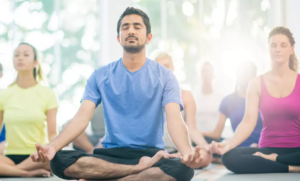What is mindfulness?

Mindfulness acts as an anchor that pulls you into the present when you start to get caught up in thoughts, emotions or unhelpful behaviours.
Throughout our day, most of us will find our minds wandering off into the future worrying about things that might happen or getting caught up in the past on memories or things we think we could have done differently, rather than being present with ourselves and what we are doing now.
-
Be present in the moment
Being present in the moment, or having conscious presence, is about being with ourselves completely in what we are doing, whilst we are doing it. It is when the body and the mind are working together in union with no extraneous thoughts coming in to distract us.
For example, going for a walk in presence is about being aware of your every movement, feeling your feet touch the ground, feeling the breeze in your face, and taking in everything that you can see around you. If a thought comes in about something that happened yesterday or perhaps about a meeting next week, this triggers us to “check out” from that presence, and therefore we no longer have the mind and the body working together as one.
What happens when you are spending so much of your life ‘time travelling’ or ‘checking out’ in this way?
- You might feel a bit lost and ‘checked out’-
- You may find that your memory and retention are being affected
- You may find it difficult to concentrate and become less productive
- You can feel disconnected from your relationships You may find that you experience more stress and anxiety
- You’re not really living your life as it is right now
-
How can mindfulness help?
Practicing mindfulness and being present with yourself can help you to cope with everyday life and deal with tough times.
Extensive research has found that mindfulness reduces stress and anxiety and strengthens the rational, problem-solving parts of your brain, helping to manage intense emotional reactions. It can also help you to concentrate, relax and be more productive as it pulls you into the present moment and helps you observe what you are doing, rather than getting caught up in autopilot. The more you can do this, the more choice you have over how you react to situations.
-
How to practice mindfulness
- Start with some everyday mindfulness:
You can start by bringing mindfulness to your everyday activities. Focusing on your senses will help you get out of your head, connect to the body and appreciate what is in front of you.
For example:
- In your morning routine, when washing your face or brushing your teeth, listen to the sound of running water, feel the sensation of water on your hands or face, smell the soap or toothpaste
- When eating breakfast, focus on the taste, texture and scent of what you are eating,
- When doing household chores like vacuuming, tidying up or washing the dishes, focus on the way you move and try to make you movements gentle and rhythmic
- In transit: driving your car, on the bus or train. Notice the sights, sounds and smells and the feel of the seat.
2. Practice mindful breathing
Take a few extra minutes to focus on your breathing. You can do this with your eyes closed or open. What does your breathing feel like? What does it sound like? Where do you first feel the breath in your body?
Try the following breathing meditations:
3. Try mindful meditation
If you’re ready to go a little deeper into developing your mindfulness, consider creating the time and space to participate in a dedicated mindfulness meditation. This could be an app on your phone with a guided mindfulness practice, attending a mindfulness group or taking yourself through a mindfulness exercise.
Click here for some mindfulness tools to try
What if I’m finding it hard?
Becoming more mindful involves training your brain, so, like most things you learn, it can take time. Be patient. Also, see below for tips on how to incorporate mindfulness into your daily routine.
Remember:
- Don’t expect to be able to hold your focus for very long, especially when you’re just getting started
- It’s completely normal for your thoughts to wander
- The goal isn’t to have a totally ‘blank’ mind; it’s more about noticing and gently guiding your mind back when your thoughts do wander
- The more you practice mindfulness, the better you’ll become at it
- Don’t give up on practicing mindfulness if you are finding it difficult. Persevere and practice
- If you’re struggling with a particular strategy, try a different one. Every person is different, and you may find some strategies easier than others.
References:
ReachOut
Bluespace Wellbeing
American Psychological Association
